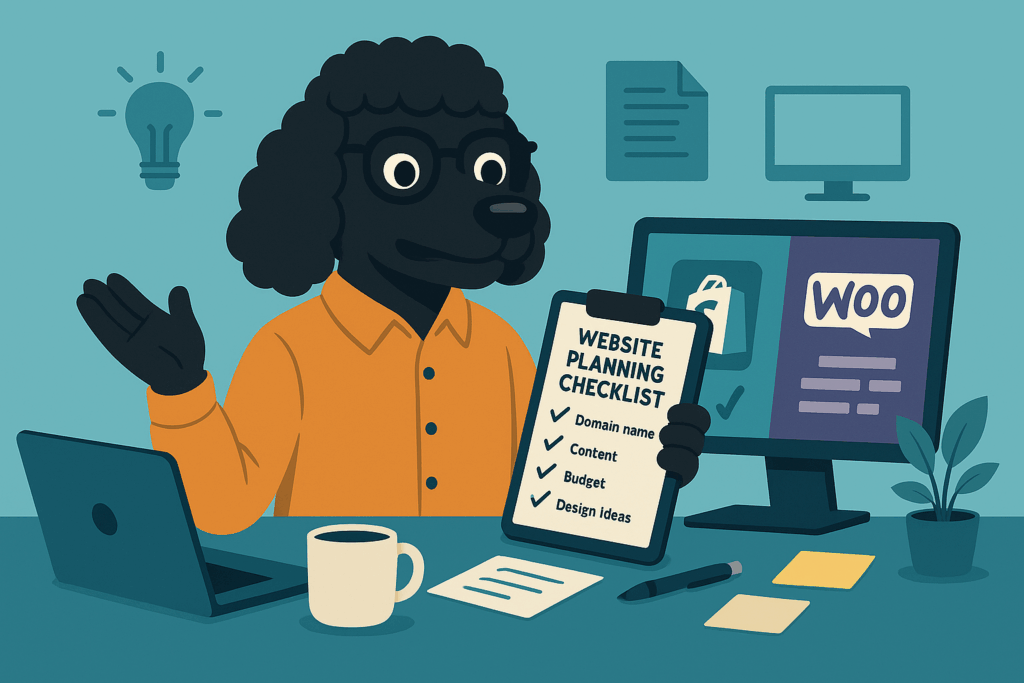What Should I Have Ready Before Speaking to a Web Developer? (Complete Website Planning Checklist)
Save time, money, and stress - use this website planning checklist before talking to a developer.

Estimated reading time: 5 minutes
Hiring a web developer is a big step — but before you send that first email or schedule a call, it’s worth asking: “What should I have prepared before I speak to a developer?”
Many people approach developers with only a vague idea of what they want. That can lead to:
- Inaccurate quotes
- Delays in project timelines
- Misunderstandings about scope and functionality
The more you prepare, the smoother your project will go. A clear plan not only saves time and money, it also helps your developer build a website that truly supports your goals.
Below is a detailed website planning checklist you can use to get ready for your first conversation with a developer.
Define Your Website’s Purpose and Goals
Every great website starts with a clear purpose. If you can’t explain why your site exists, your developer won’t be able to design it effectively.
Ask yourself:
- Is your site primarily for generating leads?
- Will it sell products through an e‑commerce store?
- Is it a portfolio site to showcase work?
- Will it be a content hub for articles, videos, or resources?
Pro Tip for SEO: If organic traffic matters to you, align your website goals with keyword research early on. For example, if you run a landscaping business, your content and structure should target relevant search terms like “garden design services” or “lawn care near me”.
Set a Realistic Budget Range
One of the first questions any developer will ask is: “What’s your budget?”
Without a range in mind, you might get proposals that are way above (or below) what you’re willing to spend.
Your budget should cover:
- Design and development costs
- Domain and hosting fees
- Content creation (copywriting, photography, video)
- Ongoing maintenance and updates
Pro Tip: Give a range rather than a fixed number, e.g. “£3,000–£5,000 for the build, plus £50–£100/month for hosting and maintenance.” This helps developers recommend realistic solutions.
Collect Design Inspiration and Branding Assets
You don’t need a finished design concept, but sharing examples of websites you like will help your developer understand your style.
Prepare:
- A Pinterest board or folder of screenshots from websites you admire
- Your brand style guide (colours, fonts, logo files)
- Notes on layout preferences — minimal, modern, bold, playful, etc.
Pro Tip: Even if a site is in a different industry, the design elements you like can help shape your own website.
Create a Basic Site Structure (Sitemap)
A sitemap is essentially a blueprint of your website. It outlines the pages you need and how they connect.
Common examples:
- Home
- About
- Services / Products
- Blog / Articles
- Contact
Pro Tip for SEO: Group your content in logical categories that also reflect target keywords. For example, a photography site might have /weddings, /portraits, and /events as separate sections.
Plan Your Website Content
A developer can’t build a finished site without content. Even placeholder text and images help with design decisions.
Consider:
- Who will write the copy? (You, a copywriter, or the developer’s team?)
- Do you have high‑quality images? (Photography is a key trust signal.)
- Will you need videos, infographics, or downloadable guides?
Pro Tip for SEO: Include keyword‑rich headings and meta descriptions in your content plan so they’re built in from the start, not added later as an afterthought.
List Required Features and Functionality
Be specific about what your site should do, not just how it should look.
Examples:
- Contact forms and lead capture
- Booking systems
- E‑commerce with payment gateways
- Membership areas
- Multi‑language support
- Blog with category filters
Pro Tip: Categorise features into:
- Must‑have (essential for launch)
- Nice‑to‑have (can be added later)
This keeps the first version of your site realistic and budget‑friendly.
Research Competitors’ Websites
Competitor research isn’t just about copying — it’s about spotting strengths to match and weaknesses to improve.
Look for:
- Common features across competitor sites
- How they structure navigation
- What kind of calls‑to‑action they use
- Their mobile design quality
Pro Tip for SEO: Check competitors’ ranking keywords with free tools like Ubersuggest or Ahrefs Free Keyword Generator. This can inform your site’s structure and content strategy.
Consider Technical Requirements
If you already have a site:
- Will you keep your current domain name?
- Do you need to migrate old content?
- Are there integrations you must keep (CRM, email marketing tools, payment systems)?
Pro Tip: Have all your logins and access details ready — domain registrar, hosting provider, CMS login — so the developer can get to work quickly.
Think About Security and Compliance
Security and legal compliance should be considered from the start.
Prepare for:
- An SSL certificate (HTTPS) for secure browsing
- GDPR‑compliant privacy and cookie policies
- Accessibility standards (screen reader support, colour contrast, alt text)
Pro Tip for SEO: Google rewards secure and accessible websites in its rankings, so these are not just legal/ethical issues — they’re also SEO opportunities.
Final Thoughts
Meeting with a web developer without preparation is like walking into a builder’s office and saying, “I want a house — just start building.”
The more you can explain:
- What your goals are
- What your budget is
- What your site should look like
- What it should do
…the smoother and faster your project will run — and the more likely you’ll end up with a site you love.
Think of this checklist as your website brief starter kit. It will help you:
- Get more accurate quotes
- Avoid scope creep
- Launch on time and on budget
If you’d like to talk to us about a website build, please click here. To follow us on Instagram for more hints and tips, click here.
